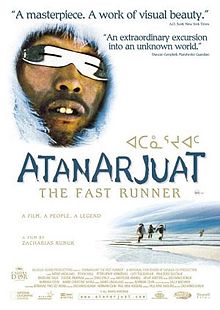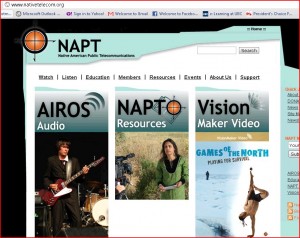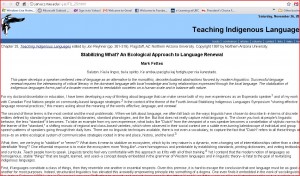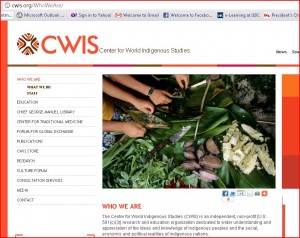Category — Module 4
Saskatchewan Aboriginal Education Research
http://www.education.gov.sk.ca/AERN
This site is a central location for coordination of research activities dealing with Aboriginal education in Saskatchewan. Although it appears to be no longer updated (copyright 2007) there are lots of links here to relevant research dealing with Aboriginal education, as well as further links to useful research tools, such as how to conduct action research for teachers, and research journals that have similar research aims.
Emily
November 27, 2011 No Comments
Siem Smun’eem – Indigenous Research Initiative
http://web.uvic.ca/icwr/imethod.htm
Siem Smun’eem – Indigenous Child Welfare Research Network. This organization is a group with membership coming from Universities, agencies and communities in British Columbia to create a unified vision of best practices in conducting research in Aboriginal communities. The mandate is to move research in the direction of local control and use. The site describes their goal, “to establish a Research Institute in the province of British Columbia to ensure our children and families are nurtured with stories, traditional teachings and practices relevant to our diverse territories, languages and teachings.” There are multiple links to relevant articles dealing with protocols and practices to conducting research within First Nations communities.
Emily
November 27, 2011 No Comments
Aboriginal Independent Community Schools
http://aics.wa.edu.au/
Aboriginal Independent Community Schools website out of Western Australia. This site describes the work of the central support unit that works to help with the delivery of education from this network of independently established community schools. These schools are all community-developed and locally run and managed. This site has some interesting information concerning the types of cultural relevance to the programming, as well as common curricular frameworks for literacy and numeracy. It serves as an example of how Indigenous communities may go about establishing their own culturally-relevant school programs, while maintaining common links to secure ongoing centrally-delivered support and funding. The site also features a showcase of projects that have resulted in positive outcomes.
Emily
November 27, 2011 No Comments
National Panel on FN Education
http://firstnationeducation.ca/home/panel-mandate/
This site concerns the mandate and work of the Canadian National Panel on First Nation elementary and secondary education. It is an ongoing process to gain input from across the country and across communities to come up with ideas and possible changes to legislation to improve education for First Nations students living on reserves. They are seeking input, which can be submitted via attendance at one of their roundtables, or directly through the site. Perhaps students in our course would like to submit their ideas to this ongoing process.
Emily
November 27, 2011 No Comments
The Arts: Traditional and Contemporary
It has come up repeatedly in our discussions that we need to stop thinking about the First Nations culture just as a static artefact from the past and need to look at their existing culture as well. So to remediate this I ventured on the Web to look for sources that would introduce me to the present day culture of the First Nations people. I examined sites that were reaching to the aboriginal people through the arts. I looked for traditional art and dance; contemporary and traditional music, movies. I was also looking for the presence of the aboriginal youth on the web: a sign of self-identity and pride. This follows from my research focus of reaching out to the aboriginal child and helping them succeed.
I’ll divide my finds in different categories.
Art
http://resources.curriculum.org/tcf/teachers/projects/repository/AboriginalArt.pdf
This document is an excellent repository about aboriginal art, myths, and their environment. While created as a teaching tool, the links are very diverse and provide in-depth knowledge about the aboriginal life style.
http://www.artistsincanada.com/php/~aboriginal.php
This is an excellent resource to find contemporary artists practicing a variety of arts. The site provides links art galleries or the artist’s website where you can see the work of these artists and also read their biographies.
Music
http://www.collectionscanada.gc.ca/aboriginal-music-song/028012-2100-e.html
This Canadian government site provides audio of many traditional songs of the aboriginal people. This is a very educational site which explains the musical instruments used and the significance of music and singing within the culture.
http://www.angelfire.com/wy/nativepride/tribal.html
This is a similar site which has songs from various aboriginal groups from the USA and Canada.
http://www.canab.com/mainpages/events/musicawards_files/2011/winners/#bestalbumoftheyear
The Canadian Aboriginal Music Award site showcases contemporary artists. It was fascinating to see the different categories of awards for aboriginal singers and to realize how diverse their contemporary music is
Dance
I was totally unaware of there were many aboriginal performance art groups that traveled around the world to show case their culture.
http://www.ksan.org/html/arts.htm
Movies
The Aboriginal groups have also joined the movie making industry and are using it brilliantly to showcase their pride and their struggle
http://www.isuma.tv/atanarjuat
Atanarjuat is Canada’s first feature-length fiction film written, produced, directed, and acted by Inuit. It is an exciting action thriller set in ancient Igloolik, the film unfolds as a life-threatening struggle between powerful natural and supernatural characters.
http://www.firstnationsfilms.com/
First Nations Films distributes and creates award-winning educational Aboriginal documentary films and videos for, by and about First Nations people. They create exclusive native programs that are shared with schools, universities, libraries, organizations and other groups and institutions.
Nureen also provided a link for Native American Public Telecommunications in her post
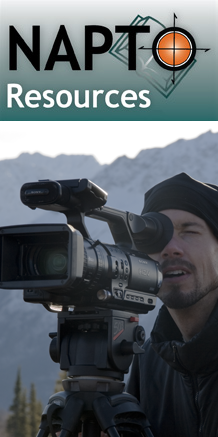
Getting Involved
We have discussed how the Web can be used by the aboriginal people to reach out and share ideas. I found some examples of the younger generation showing pride in their cultural believes.
What Counts:
https://www.youtube.com/watch?v=keczbYdbvpE
I Can Tell You a Legend: The Mink Story – Gwa’sala-‘Nakwaxda’xw Digital Storytelling
https://www.youtube.com/watch?v=iBcTQF5qYFQ
November 26, 2011 No Comments
NAPT Native American Public Telecommunication
The Native American Public Telecommunication (NAPTA) is a resource for sharing Native stories globally through the use of the Web in an effort to support the creation, promotion and distribution of Native media. This creates a trusted venue for Native voices to be conglomerated and resources to be collected and shared with the public. NAPTA helps build relationships between Native producers, public television and radio. NAPTA also gets assistance from Native producers to create, produce and share educational telecommunication programs for various types of media such as public television and radio. NAPTA encourages individuals from Native backgrounds by training them to create public broadcasting programs of quality some of which are geared at advocating for the use of technologies. NAPTA’s goal is to build relationships with Native communities and organizations and creating media that can be used as a means of sharing Native perspectives globally. The programs are created with the vision of making Natives visible and trying to achieve equity through the use of media. Furthermore, these types of media are a good source of highlighting and honouring components of Native culture such as heritage, wisdom and storytelling.
Below are some URL links about language revitalization and language endangerment. These videos are examples of media that NAPTA tries to showcase.
First Nations Language Revitalization
https://www.youtube.com/watch?v=xxJr7yw1j2A
Saving First Nations Languages
November 26, 2011 No Comments
Stabilizing What? An Ecological Approach to Language Renewal
This paper by Mark Fettes is interesting because it has a different take on analyzing language and renewal of language. The author talks about language renewal and how this requires a combination of knowledge and skill from the dominant language as well as knowledge, skills and relationship associated with native languages. The author believes that renewal of language can help restore society while balancing it with nature. He conveys that language is linked to all aspects of life in indigenous cultures. Thus, language associations result in what beliefs and practices a person has and impact how they will live life and be a part of the world.
November 26, 2011 No Comments
CWIS Center for World Indigenous Studies
The Center for World Indigenous Studies (CWIS) is an independent, non-profit organization that is based on research and education. The intent of this organization is to help people develop a broader understanding and appreciation for aspects of indigenous society such as social, economic and political views. This institution strives to educate the public by publishing and distributing ideas, views and voices of individuals from sub-populations who struggle with social exclusion in society. An important goal of CWIS is to establish cooperation between nations; and, to democratize international relations between nations and between nations and states. Dr. Rudolph C. Rÿser, Ph.D. and Chief George Manuel of the Shuswap Tribal Nation founded this independent organization. The organization originated as a means of archiving tribal documents and then transitioned to an organization based on research, education and policy analysis for Aboriginal groups.
November 26, 2011 No Comments
Dare to Lead is …..making the difference
Dare to Lead is a commonwealth funded national project that is focussed on improving educational outcomes for Aboriginal students. This organization began in 2000. It is funded by the Government of Australia, the Ministry of Education and Employee and Workplace Relations. It is an initiative of Principals Australia (formerly known as Australian Principals Association Professional Development Council). Fifty-three percent of Australian schools are officially associated with this agency. Statistics have shown that students from Aboriginal backgrounds inAustraliaare scoring lower, academically. Hence, this network’s goal is to improve Indigenous students’ outcomes by assisting schools to successfully support pre-existing programs and to implement new initiatives to assist these students with their academic success. This process also allows for all students to be exposed to aboriginal culture; thus, fostering a better societal understanding. The Dare project also collects data and makes reports about project activity as well as Indigenous student outcomes.
http://www.daretolead.edu.au/DTL2009_Home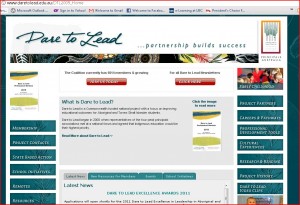
November 26, 2011 No Comments
INDIGENOUS PEOPLES’ RESTORATION NETWORK
The Indigenous Peoples’ Restoration Network’s (IPRN) was established as an effort to support native and tribal communities with environmental restoration and cultural rehabilitation through the use of technology. The purpose of this agency is to assist leaders and practitioners from these societies to use their traditional ecological knowledge (TEK) and their own views and practices in conjunction with technology to achieve their ecological goals. Aboriginal cultures can accomplish this by employing the use of ecological restoration tools to ensure the survival of their culture and people. This would require the combination of traditional ecological knowledge from indigenous communities with newer models of sustainable agro-ecosystem management.
http://www.ser.org/iprn/default.asp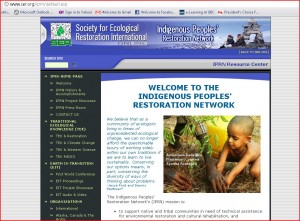
The following URL (http://www.ser.org/iprn/tek.asp) is for a section on this website that explains what traditional ecological knowledge (TEK) is, its purpose and how it is a huge part of Aboriginal society.
November 26, 2011 No Comments




